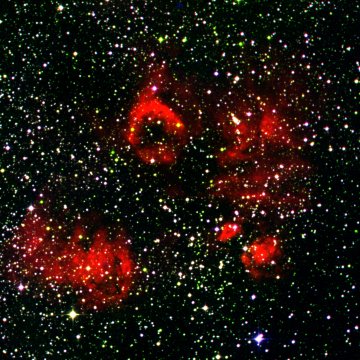Sh 2-53
Also called
RCW 166Coordinates: (18.2°, -0.3°)
[ Catalog | Explorer | SIMBAD ]
Avedisova places the nebula in the complex star formation region SFR 18.18-0.30, which includes 4 molecular clouds, a methanol maser and at least 4 additional HII regions visible at radio and infrared frequencies.
You can view a good black and white hydrogen-alpha image here.
The region is prominent in infrared as can be seen in this Spitzer image.
This nebula is mentioned in connection to gamma ray source 2EG J1825-1307, which is assigned a distance estimate of 4300 parsecs. SIMBAD identifies this gamma ray source with the pulsar PWN G18.0-0.7 and the supernova remnant SNR 018.0-00.7.[2]
This is in the same area of sky as the Scutum supershell.[3]
Notes
1. ^ Kassim, Namir E., Weiler, Kurt W., Erickson, William C., et al. (1989). "Improved estimates of galactic H II region emission measures and filling factors - Low-frequency VLA observations near Sharpless 53", The Astrophysical Journal, Vol. 338, 152-161. [1989ApJ...338..152K]
2. ^ Yadigaroglu, I.-A. & Romani, Roger W. (1997). "Gamma-Ray Pulsars and Massive Stars in the Solar Neighborhood", The Astrophysical Journal, Vol. 476, 347. [1997ApJ...476..347Y]
3. ^ Callaway, Matthew B., Savage, Blair D., Benjamin, Robert A., et al. (2000). "Observational Evidence of Supershell Blowout in GS 018-04+44: The Scutum Supershell", The Astrophysical Journal, Vol. 532, 943-969. [2000ApJ...532..943C]
Distance estimates
3798 pc [2003A&A...397..213P]4500 pc [1989ApJ...338..152K]
4300 pc [1997ApJ...476..347Y]
Links
[ DSS | ADS | ADS Abstract ]
map | book | blog | gallery | sources

This image was created using the POSS-II/UKSTU data of the Digitized Sky Survey and SuperCOSMOS using the process described here.
According to my correspondence with the Royal Observatory Edinburgh and the Space Telescope Science Institute, I am allowed to use the POSS-II/UKSTU data to create and display images for non-commercial purposes so long as I include this fine print for the SuperCOSMOS data:
Use of these images is courtesy of the UK Schmidt Telescope (copyright in which is owned by the Particle Physics and Astronomy Research Council of the UK and the Anglo-Australian Telescope Board) and the Southern Sky Survey as created by the SuperCOSMOS measuring machine and are reproduced here with permission from the Royal Observatory Edinburgh.
and this acknowledgement taken from the DSS site:
The Digitized Sky Surveys were produced at the Space Telescope Science Institute under U.S. Government grant NAG W-2166. The images of these surveys are based on photographic data obtained using the Oschin Schmidt Telescope on Palomar Mountain and the UK Schmidt Telescope. The plates were processed into the present compressed digital form with the permission of these institutions.
The Second Palomar Observatory Sky Survey (POSS-II) was made by the California Institute of Technology with funds from the National Science Foundation, the National Geographic Society, the Sloan Foundation, the Samuel Oschin Foundation, and the Eastman Kodak Corporation.
The UK Schmidt Telescope was operated by the Royal Observatory Edinburgh, with funding from the UK Science and Engineering Research Council (later the UK Particle Physics and Astronomy Research Council), until 1988 June, and thereafter by the Anglo-Australian Observatory. The blue plates of the southern Sky Atlas and its Equatorial Extension (together known as the SERC-J), as well as the Equatorial Red (ER), and the Second Epoch [red] Survey (SES) were all taken with the UK Schmidt.
The "Second Epoch Survey" of the southern sky was made by the Anglo-Australian Observatory (AAO) with the UK Schmidt Telescope. Plates from this survey have been digitized and compressed by the ST ScI. The digitized images are copyright ? 1993-5 by the Anglo-Australian Observatory Board, and are distributed herein by agreement.
The "Equatorial Red Atlas" of the southern sky was made with the UK Schmidt Telescope. Plates from this survey have been digitized and compressed by the ST ScI. The digitized images are copyright ? 1992-5, jointly by the UK SERC/PPARC (Particle Physics and Astronomy Research Council, formerly Science and Engineering Research Council) and the Anglo-Australian Telescope Board, and are distributed herein by agreement.
The compressed files of the "Palomar Observatory - Space Telescope Science Institute Digital Sky Survey" of the northern sky, based on scans of the Second Palomar Sky Survey are copyright ? 1993-1995 by the California Institute of Technology and are distributed herein by agreement. The compressed files of the "Palomar Observatory - Space Telescope Science Institute Digital Sky Survey" of the northern sky, based on scans of the Second Palomar Sky Survey are copyright ? 1993-1995 by the California Institute of Technology and are distributed herein by agreement.